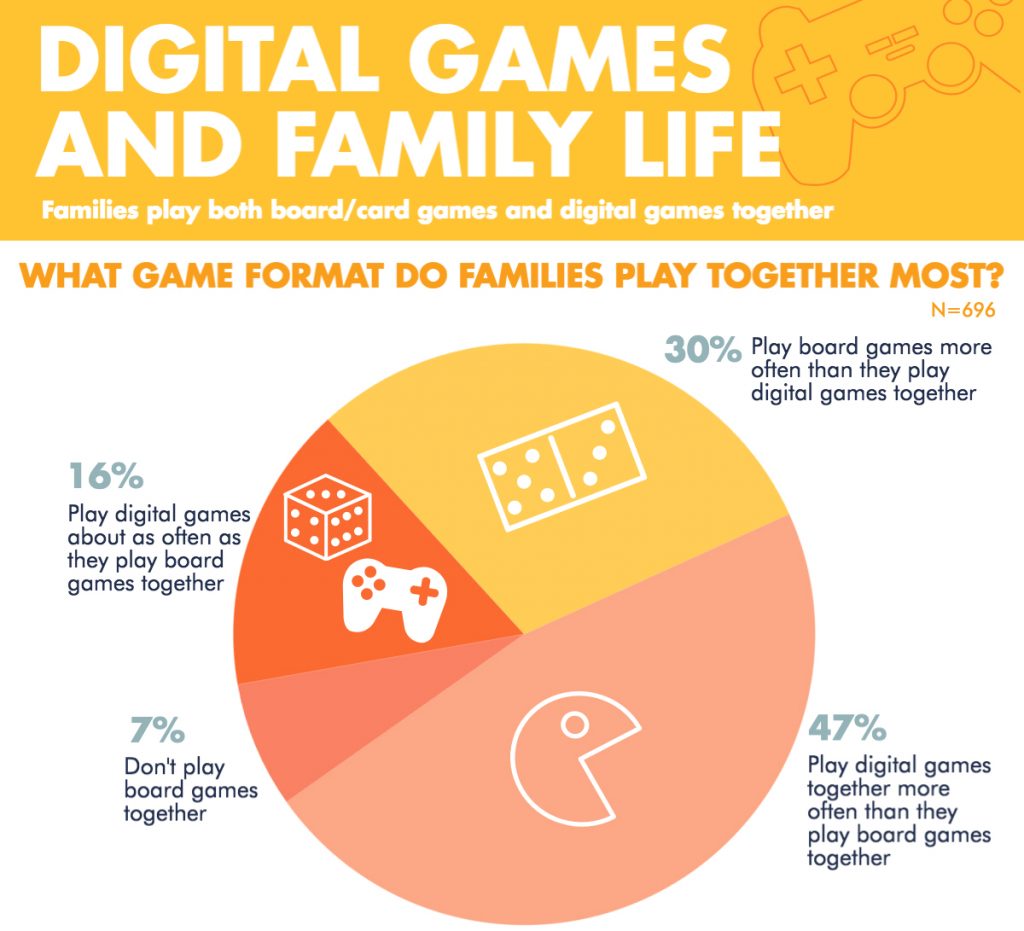When I was a kid, one of my favorite parts of the week was the recurring Friday night game session at my house. It usually consisted of my dad stoking the fire, my sister watching TV, and my mom and me embroiled in a fierce competition of Chinese Checkers or Othello. There may have been times I fumed while resetting the board pieces (I was not a good loser), but I always enjoyed those game nights and still hold onto those memories today.
Now, with a family of my own and three kids with busy schedules (much busier and more jam-packed than mine ever was!), weekly game nights have unfortunately never become an official event. And the definition of gaming has changed quite a bit, too. There will always be a good ol’ fashioned game of Checkers to fall back on, but when you weave in the digital world, with video games, apps, online games, and even VR, there are almost limitless ways to play together.
 It’s interesting to see how families are playing these days. According to a recent infographic by the Joan Ganz Cooney Center, 93% of families with 4 to 10-year-olds still play board games with their kids. Hooray for Life! Which also happens to be one of the iconic board games that families are now playing in digital form, along with other familiar titles like Monopoly, Uno, Risk, and Scrabble. Even for families that like to whip out the board games on occasion, 51% are choosing to play together digitally more often than with traditional board games.
Thinking about my own family’s gaming habits, we seem to fall into the smaller group of people—the 32% who play board games more often than digital games. My kids love when we break into a spontaneous game of Apples to Apples or Family Trivial Pursuit, and will never turn down a game of Uno, but they also like to bust a move during a family Just Dance challenge. There’s nothing cuter than watching little kids mimic those dance moves.
I try to insert myself into my kids’ screen time wherever I can, because I know it gets harder as kids get older and become individual tech silos. I love playing Toca Boca apps with my 3-year-old because not only are they really fun, they also allow me into her digital world. Those interactions teach her that screen play can be a shared activity.
Despite the power of the screen and how easy it is for everyone to just be on their own gadgets, it’s nice to know that in this highly digital age, lots of families are still taking the time to game together. Whether you’re playing online or offline, the most important takeaway is to keep the family gaming game strong (excuse the pun).
As much as tech is entrenched into my life—it is my job after all—I’m still a sucker for rolling a pair of dice and moving pieces on a board. I think I know what we’re doing next Friday night.
See the full infographic here and learn more about the series here.
It’s interesting to see how families are playing these days. According to a recent infographic by the Joan Ganz Cooney Center, 93% of families with 4 to 10-year-olds still play board games with their kids. Hooray for Life! Which also happens to be one of the iconic board games that families are now playing in digital form, along with other familiar titles like Monopoly, Uno, Risk, and Scrabble. Even for families that like to whip out the board games on occasion, 51% are choosing to play together digitally more often than with traditional board games.
Thinking about my own family’s gaming habits, we seem to fall into the smaller group of people—the 32% who play board games more often than digital games. My kids love when we break into a spontaneous game of Apples to Apples or Family Trivial Pursuit, and will never turn down a game of Uno, but they also like to bust a move during a family Just Dance challenge. There’s nothing cuter than watching little kids mimic those dance moves.
I try to insert myself into my kids’ screen time wherever I can, because I know it gets harder as kids get older and become individual tech silos. I love playing Toca Boca apps with my 3-year-old because not only are they really fun, they also allow me into her digital world. Those interactions teach her that screen play can be a shared activity.
Despite the power of the screen and how easy it is for everyone to just be on their own gadgets, it’s nice to know that in this highly digital age, lots of families are still taking the time to game together. Whether you’re playing online or offline, the most important takeaway is to keep the family gaming game strong (excuse the pun).
As much as tech is entrenched into my life—it is my job after all—I’m still a sucker for rolling a pair of dice and moving pieces on a board. I think I know what we’re doing next Friday night.
See the full infographic here and learn more about the series here.
 Jeana Lee Tahnk is a family tech expert and mom of three who is also navigating a new world of digital parenting. She is a regular contributor to Mashable, The Huffington Post, Cool Mom Tech and more, and is often sought out for her commentary on the intersection of parenting and technology.
Jeana Lee Tahnk is a family tech expert and mom of three who is also navigating a new world of digital parenting. She is a regular contributor to Mashable, The Huffington Post, Cool Mom Tech and more, and is often sought out for her commentary on the intersection of parenting and technology.
 It’s interesting to see how families are playing these days. According to a recent infographic by the Joan Ganz Cooney Center, 93% of families with 4 to 10-year-olds still play board games with their kids. Hooray for Life! Which also happens to be one of the iconic board games that families are now playing in digital form, along with other familiar titles like Monopoly, Uno, Risk, and Scrabble. Even for families that like to whip out the board games on occasion, 51% are choosing to play together digitally more often than with traditional board games.
Thinking about my own family’s gaming habits, we seem to fall into the smaller group of people—the 32% who play board games more often than digital games. My kids love when we break into a spontaneous game of Apples to Apples or Family Trivial Pursuit, and will never turn down a game of Uno, but they also like to bust a move during a family Just Dance challenge. There’s nothing cuter than watching little kids mimic those dance moves.
I try to insert myself into my kids’ screen time wherever I can, because I know it gets harder as kids get older and become individual tech silos. I love playing Toca Boca apps with my 3-year-old because not only are they really fun, they also allow me into her digital world. Those interactions teach her that screen play can be a shared activity.
Despite the power of the screen and how easy it is for everyone to just be on their own gadgets, it’s nice to know that in this highly digital age, lots of families are still taking the time to game together. Whether you’re playing online or offline, the most important takeaway is to keep the family gaming game strong (excuse the pun).
As much as tech is entrenched into my life—it is my job after all—I’m still a sucker for rolling a pair of dice and moving pieces on a board. I think I know what we’re doing next Friday night.
See the full infographic here and learn more about the series here.
It’s interesting to see how families are playing these days. According to a recent infographic by the Joan Ganz Cooney Center, 93% of families with 4 to 10-year-olds still play board games with their kids. Hooray for Life! Which also happens to be one of the iconic board games that families are now playing in digital form, along with other familiar titles like Monopoly, Uno, Risk, and Scrabble. Even for families that like to whip out the board games on occasion, 51% are choosing to play together digitally more often than with traditional board games.
Thinking about my own family’s gaming habits, we seem to fall into the smaller group of people—the 32% who play board games more often than digital games. My kids love when we break into a spontaneous game of Apples to Apples or Family Trivial Pursuit, and will never turn down a game of Uno, but they also like to bust a move during a family Just Dance challenge. There’s nothing cuter than watching little kids mimic those dance moves.
I try to insert myself into my kids’ screen time wherever I can, because I know it gets harder as kids get older and become individual tech silos. I love playing Toca Boca apps with my 3-year-old because not only are they really fun, they also allow me into her digital world. Those interactions teach her that screen play can be a shared activity.
Despite the power of the screen and how easy it is for everyone to just be on their own gadgets, it’s nice to know that in this highly digital age, lots of families are still taking the time to game together. Whether you’re playing online or offline, the most important takeaway is to keep the family gaming game strong (excuse the pun).
As much as tech is entrenched into my life—it is my job after all—I’m still a sucker for rolling a pair of dice and moving pieces on a board. I think I know what we’re doing next Friday night.
See the full infographic here and learn more about the series here.
 Jeana Lee Tahnk is a family tech expert and mom of three who is also navigating a new world of digital parenting. She is a regular contributor to Mashable, The Huffington Post, Cool Mom Tech and more, and is often sought out for her commentary on the intersection of parenting and technology.
Jeana Lee Tahnk is a family tech expert and mom of three who is also navigating a new world of digital parenting. She is a regular contributor to Mashable, The Huffington Post, Cool Mom Tech and more, and is often sought out for her commentary on the intersection of parenting and technology.